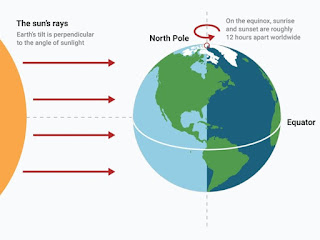Equinox, Solar - Lunar Eclipse Seasons KAS Study Notes
Equinox
![[feature] Solar and Lunar Eclipse Equinox Solar and Lunar Eclipse Equinox](https://blogger.googleusercontent.com/img/b/R29vZ2xl/AVvXsEhdI_eQnBZKuFaMNWB7wuIRndkOop2cA5nWO_5Syi3pjcwYOokYKVIA8xXwOu6yrGuSpmMsiJlfoYLAKSX0WjyU49wvgDBC4qeTLTOGCAgWnhOiAs5xfaqzoO2UujNcqa99-DwRTl-zC8JO/s1600/solar-and-lunar-eclipse.jpg)
Equinoxes occur when the earth reaches the points in its orbits where the equatorial and the orbital planes intersect, causing the sun to appear directly overhead at the equator.
During the equinoxes the periods of day light and darkness are equal all over the world.


Autumnal Equinox
Neither pole of the earth is inclined towards the sun.
The rays of the sun fall vertically on the equator. All the places have equal days and nights.
It is autumn in the northern hemisphere and spring in the southern hemisphere.
This day (23 September) when sun’s rays for fall verticaly on the equator, is known as autumnal equinox
Spring Equinox
Neither pole of the earth is inclined towards the sun. The rays of the sun fall vertically on the equator.
All the places have equal days and nights as both the poles receive the rays of the sun.
It is spring in the northern hemisphere and autumn in the southern hemisphere.
This day (21 March) is known as spring equinox.
Variation in Day Time


Eclipses

An eclipse is a complete or partial obscuration of light from a celestial body and it passes through the shadow of another celestial body.
The eclipses are of two types. They are:
Solar Eclipse
Lunar Eclipse
Solar Eclipse
It occurs on New Moon days, when the Moon is between the Sun and the Earth (EMS)
Thus it obscures a part of the Sun viewed from the Earth, but only from a small area of the world. It lasts only for a few minutes.
They occurs in three types
A Partial solar eclipse happens when the moon partially covers the disc of the sun.
An Annular solar eclipse occurs when the moon passes centrally across the solar disc.
Total solar eclipse, the moon’s shadow is short enough to cover the whole sun. The outer regions still glow and look bright as a ring. Such a phenomenon is called Diamond Ring.

Lunar Eclipse

It occurs on a Full Moon position when the earth is between the sun and the moon (MES)
The earth’s shadow obscures the moon as viewed from the earth.
A partial lunar eclipse can be observed when only a part of the moon’s surface is obscured by earth’s umbra
A penumbral lunar eclipse happens when the moon travels through the faint penumbral portion of the earth’s shadow.
A total lunar eclipse occurs when the earth umbra obscures the entire the moon’s surface.
Lunar eclipse can be seen from anywhere on the night side of the Earth.
It lasts for a few hours due to the smaller size of the moon.
Moon is still visible to the naked eye in Red Color. This is because Earth's atmosphere bends sunlight and indirectly lights up the Moon's surface.
[post_ads]











COMMENTS